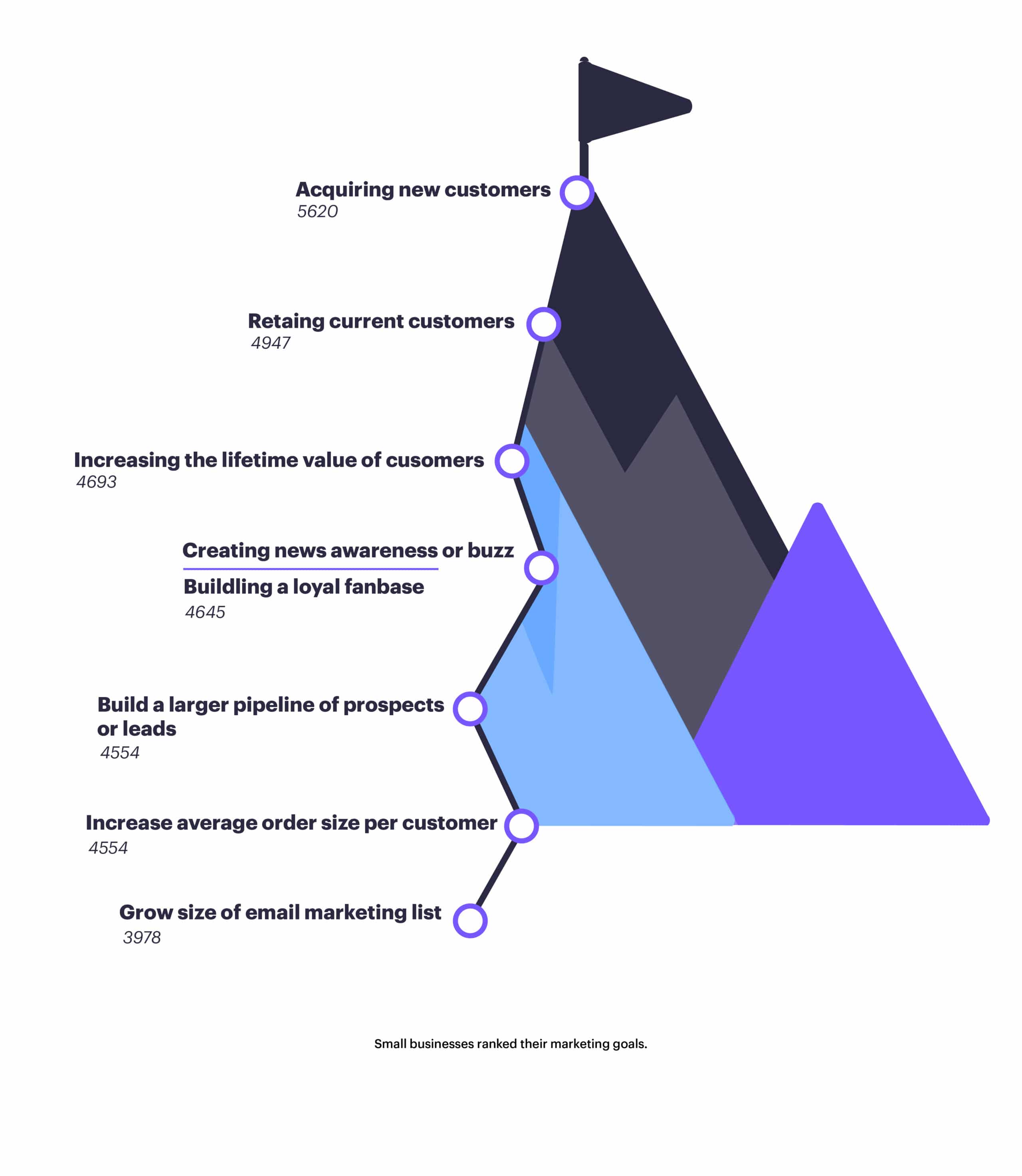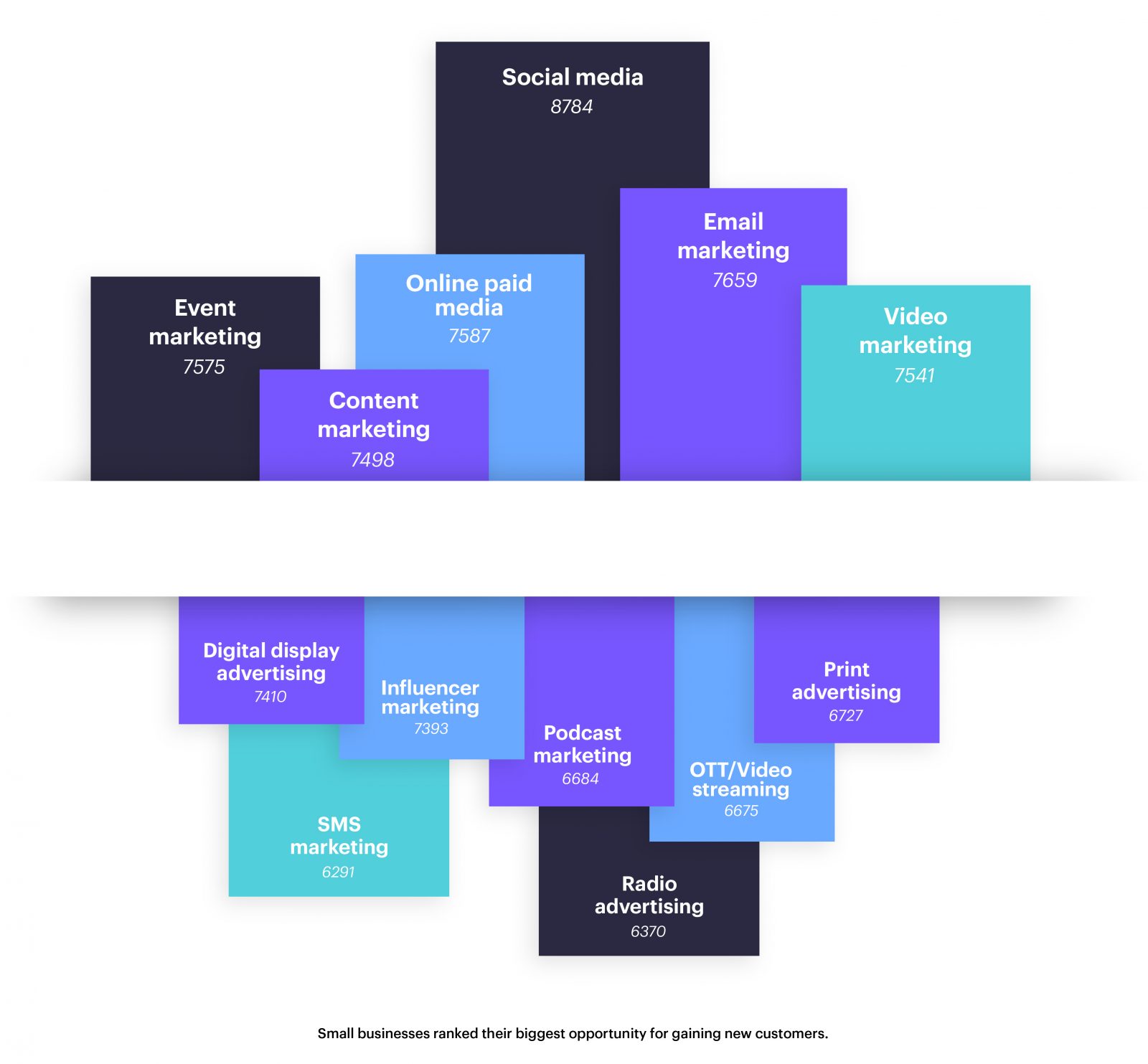During our recent research on the current state of small businesses, one of the topics we focused heavily on was the marketing challenges and goals small businesses currently have for this year.
For this research, we reached out to 1,000 small businesses, with 100 or fewer employees and asked them what their biggest marketing challenges were and what goals they have for 2019, and this is what they had to say.
Small business marketing challenge: Customer acquisition and increasing leads
After taking the time to review the results of our survey, we noticed that, when asked, the majority of small businesses stated that one of their biggest marketing challenges was not only new customer acquisition, but also increasing new, quality leads.
New customer acquisition beat out increasing prospects and leads by only a few points, but the two go hand in hand.
Small business marketing goals for 2019: Acquiring new leads and retaining old ones
When it came time for us to tally up the totals for the top goals that small businesses had for 2019, we weren’t surprised to see that acquiring new leads was the top performer, closely followed by retaining current customers.
While these trends were the result of our small business survey, businesses of all sizes tend to share the same thoughts when it comes to their goals because, to thrive, a business needs to be filling their sales funnel continuously. Having the right marketing strategy is what helps to drive these new leads through your funnel, but, before we talk strategy, let’s see what those surveyed had to say about their plans to reach their goals for this year.
How can small businesses best address these goals?
During our research, we asked these small businesses how they planned to address their marketing goals for the year, and the majority stated that their best chance for new customer acquisition was through social media, followed closely by email marketing.
Methods for gaining and nurturing leads
Based on our findings, we thought it’d benefit our readers to talk a bit about each of these methods for gaining and nurturing leads and prospects. Both social media marketing and email marketing are valuable channels to explore, so it’s ultimately up to the individual brand to choose which one benefits them and their efforts the most.
Social media marketing
Social media marketing platforms, such as Twitter, Facebook, and Instagram, are great options for nurturing your relationship with your audience and is a viable channel for acquiring new ones as well. In fact, 77.6% of small businesses have reported that they’ve used social media to promote their business. Even better, 90% of marketers state that their social media marketing efforts have increased exposure for their business, while 75% stated that they’d noticed an overall uptick in traffic.
With the total number of social media accounts worldwide estimated to hit 2.9 billion this year, and marketing numbers like those above, it’s no surprise why the small businesses we surveyed stated that they see social media as a top contender for helping them reach their customer-based goals in 2019.
Email marketing
Email marketing, simply put, is the strategy of sending out marketing materials to a given subscriber list that’s chosen to opt-in to receiving your content. While many want to believe that email marketing is a dying practice, that simply couldn’t be further from the truth. It’s more alive than ever, thanks to our ever-changing technology.
Did you know, when compared to the total number of accounts on Facebook and Twitter worldwide, there are 3x the number of email accounts? Moreover, did you know that an email is 6x more likely to receive a click-through than a tweet?
Is one marketing channel more beneficial than the other?
When choosing which marketing channel is better, it comes down to the businesses’ overall goals and what they expect to see in their total return on investment. While social media is excellent for connecting with your audience, it doesn’t show the ROI that email marketing does.
Determining the ROI of social media marketing can get a little bit tricky, simply because the algorithms are always changing, and now marketers are finding that they have to invest more in PPC posts than they have in the past, simply because the organic reach is no longer there. In fact, one study showed that only around 48% of marketers see any ROI from social media.
When it comes to defining the ROI of email marketing, however, things take a drastic turn—and for the better. Email marketing, on average, sees about a 4400% ROI, which breaks down to $44 for every $1 spent.
So, while we believe that both social media and email marketing are valuable channels for small business marketing, if you’re looking for a steadier ROI, then you’ll want to prioritize your email marketing efforts over social media marketing. It’s also worth noting that 61% of consumers actually prefer to hear from and receive promotional materials from their favorite brands through email.
4 email marketing basics for small businesses
Email marketing can be combined with not only social media marketing but other channels as well to keep your audience informed and encourage engagement. Since this channel has proven to have highest overall ROI, it’s vital that small businesses get a solid understanding of not only what email marketing is, but how to put together a solid small business marketing strategy that revolves around email and email automation.
1. Establish your goals and objectives.
The very first step a small business needs to take when building their email marketing strategy is to sit down and establish their goals and objectives. These can be any number of things, including:
- Drive new signups
- Create new leads
- An increase in donations for your nonprofit
- Increase profits/Remaining profitable
You want to make sure every goal/objective is defined down to the very last detail because, if they’re too generic, the chances of reaching them are much slimmer.
2. Begin or continue to build your email list.
If you haven’t yet, then it’s time to start focusing your efforts on building your email list. The list should be made up of addresses from people who’ve expressly stated that they want to receive your marketing content.
It can be done through an email opt-in or through leads like forms on your website or social media profiles. However, each lead that you receive must go through an opt-in or verification process that explicitly states they want to receive your content.
3. Plan and design your campaign.
This is where you’ll decide which type of email campaign you want to create and send to your readers. Email campaigns come in many forms, including:
- Newsletters
- Announcements
- Marketing offers
- Event invitation
- Product launch/update
- A welcome email
- Seasonal campaign
- Post-purchase drip campaign
Once you’ve decided on the type of campaign, it’s time to get creative and start the designing process. One pro tip for small businesses is to test, test, and retest during and after the design process. By performing simple A/B tests, you’ll be able to see which features work well with your readers and which don’t, helping to guide you to build the best campaign possible.
4. Monitor your results.
Once you’ve finalized your campaign and sent it out to your subscribers, you’ll want to monitor the campaign to see how well it performs carefully. It can be done by keeping a close eye on some key performance indicators (KPIs), such as your:
- Open rates
- Click rates
- Click-through rates
- Conversion rates
- Unsubscribe rates
- Bounce rates
- Spam rates
Carefully watching these KPIs will help you see which campaigns are being opened, which are helping you increase your traffic rates, and which ones are complete flops.
Our email marketing cheat sheet
To help small business marketing teams better understand the importance of email marketing to their overall marketing strategy, we went ahead and completed this email marketing cheat sheet for quick and simple reference.
Wrap up
While each marketing channel has something to offer small business marketing teams, some provide better results than others. While social media is an exceptional marketing channel, email marketing has proven to provide the best overall results. Just remember, when done right, combining different marketing channels can help small businesses see even better results.
Combining social media with your email marketing can help with:
- New lead acquisition
- Increasing your prospect list
- Nurturing current leads through polls and surveys
Ready to get started with building your first email marketing campaign? Let Campaign Monitor simplify the process with our easy to use email builder.








